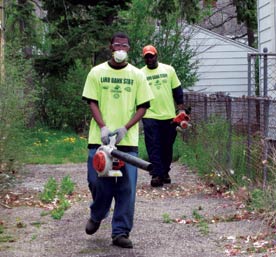
Genesee County Land Bank
Last fall, the Federal Housing Finance Agency sought comments on how Fannie Mae, Freddie Mac, and the Fair Housing Administration can divest themselves of their massive inventory of real-estate-owned properties. Among the ideas gaining traction is selling homes for rental rather than owner-occupancy, as in the GSEs’ recently rolled out REO to rental pilot project. A big REO auction could give community groups a shot at developing much-needed affordable rental housing, but they will face stiff competition from for-profit investors.
If nonprofits are able to pick up properties, they’ll have another major challenge: managing scattered-site rental. While many nonprofit organizations now manage multi-family buildings, having single-family homes spread over a wide area is much more difficult, logistically.
No Efficiencies of Scale with Scattered-Site
All sorts of costs — from trash removal, to travel time and gas for maintenance crews — become much less efficient when the same number of rental units are spread around in many buildings across a wide geographic area.
Ithaca Neighborhood Housing Services has been managing scattered-site rental housing since the early 1980s. Their stock ranges from five-family buildings to duplexes and one single-family home, and is mostly quite old. Sandy Conrad, a property manager at Ithaca NHS, notes that one of the issues with scattered site is “you’re going to have different types of fixtures within the same building, in different units.” That can make repairs more costly, because the maintenance staff has to either keep a huge inventory of different kinds of fixtures, or drive to get the necessary part every time. Unless you have the cash upfront to make a wholesale replacement of fixtures, this sort of piecemeal upgrading gets costly.
Drive time turns out to be another overlooked cost of scattered-site management. Lori Neally is the director of Gilman Property Management, a subsidiary of Gilman Housing Trust in Lyndonville, Vermont. The distance between her two most spread out properties is “a little over 100 miles — if it was a straight shot,” which, of course, it isn’t. The staff time and gas spent driving between houses gets expensive fast, she said.
Distance also gets factored in to the costs of supplies. “It’s closer to go to the little mom-and-pop hardware store, but it may cost us five dollars more,” Neally said. “But it may save us money in gas,” she added, so she tries to find a balance.
Along with repairs, regular maintenance doesn’t scale well either. Boston-based Chelsea Neighborhood Developers has 86 units in 18 buildings. This means that “rather than having one Dumpster for 86 units, or maybe two,” says David Keene, director of finance and operations, the maintenance crew has to drag out 18 sets of trashcans or Dumpsters every week. The same goes for snow shoveling: the maintenance crew has to go from building to building every time it snows.
Laundry machines pose yet another problem. With only two or three families per building, the washing machine company doesn’t do enough business to cover costs, so the rents on the units have to subsidize the machines. While having the machines is an additional expense to factor in, “We feel that it’s important for our residents, particularly the ones who have families, as most of our residents do,” Keene said.
Security is also much harder with an inventory of scattered-site one- to four-unit homes than a single development. “We buy a property, it’s secure, and then two days before closing someone goes in and steals all the copper,” says Keene.
All of these mundane costs add up to scattered-site rental management costing about 25 or 30 percent more than traditional rental housing, estimates Ivan Levi of the Community Development Trust in New York City.
It’s more expensive, and more unpredictable. The Flint, Michigan-based Genesee County Land Bank generally breaks even on its rental properties. “Last month we had about $30,000 in rental income, and about $27,000 in expenses,” says executive director Douglas Weiland. But, he adds, that breakdown can swing wildly if something goes wrong. “The expenses are irregular, because if on any one of these houses we have to replace a furnace, it’s a couple thousand dollars that’s not planned. If on any one of these houses we have to replace the roof, that’s a couple of thousand dollars that’s not planned.” With a large pool of scattered-site rentals, that’s many roofs and boilers that can break.
Doing It Anyway
Though additional costs and headaches like these have kept many nonprofit organizations from taking on scattered-site rental at all, some mission-driven organizations have not been dissuaded. “Scattered-site rentals provide nonprofits with a strong physical presence and stakeholder role within a neighborhood, enabling them to be more involved in local political lobbying and neighborhood change,” says Benji Power of Neighborhood Housing Services of South Florida. These units also allow nonprofits to demonstrate proper property condition standards, and they can serve as demonstration units for many different programs.
Others view scattered-site rental management favorably because it’s an effective way to provide affordable housing: “Any opportunity to secure affordable housing for our residents is one that we should implement,” says Mark Asturias of the Irvine Community Land Trust in Irvine, California.
Others, like the Genesee County Land Bank, backed into it unintentionally, “more by accident than by design,” as Weiland says. The land bank acquires properties through the city’s annual tax foreclosure process, and they’re often in bad shape. “These properties have come through the system because they could not pay their taxes, and they generally could not afford to pay for maintenance either,” he says.
The land bank will sell off those properties it can and demolish those it needs to, but for some occupied properties, continuing to rent them is the right course of action. At any given time, Weiland says, they have 80 to 90 properties under rental management. Many of those tenants will eventually buy the home, on a lease-purchase model. But some stay renters for the long haul. “With the economic circumstances we have here today … we wind up becoming the housing provider of last resort,” says Weiland.
John O’Callaghan, president and CEO of Atlanta Neighborhood Development Partnership (ANDP), said it’s a challenge that needs to be figured out. As homeownership has moved out of reach for many people, renting has taken center stage. “Families need shelter, and neighborhoods need residents. The reality is … rental’s got to be increased [as a] disposition for single-family homes,” he says.
O’Callaghan says that while having early money on-hand to function at capacity is the ideal scenario, starting off small, as ANDP did, allows an organization to establish a track record of success that can actually make it easier to attract investors. “By doing that, you’re able to get the resources to do it to scale. Our goal is to get high scale and as our capacity is now stronger, we have a better opportunity to bring this to scale.”
More capital makes for more effective scattered-site management because at this point, ANDP exclusively uses third-party contractors, so in-house capacity limitations are no longer an issue, O’Callaghan says. “We get better pricing and we have direct relationships with suppliers.” That said, he added, the primary benefit of a fully capitalized operation “stems from our ability to now deliver quality product at a more affordable price at a lower financing cost. You have to have a positive cash flow to do this at scale.”
While nonprofits often find scattered-site rental to be a daunting prospect, there are for-profit companies that specialize in it. Real Property Management, for example, is a company that manages more than 50,000 properties nationwide for owners that include large enterprises and banks who have contracted with RPM under the Protecting Tenants in Foreclosure Act, as well as smaller owners with an average of one or two properties.
Though their properties are scattered, the firm has a national network of 200 offices and it is fairly close to all of its properties. More, they have a formula they apply to each property. When RPM acquires an REO property, they budget for a three-month period in which the house will be vacant, said RPM principal Tom Eggleston. “Most require clean or replaced carpet, interior painting,” he said, “replaced linoleum in the kitchen, etc. There’s real work over a three- to four-week period. Then you commence the marketing, and that’s another three- to four-week period.” Then showing the house and screening applicants takes another few weeks. The vacant months also require monitoring of the property. “You’ve made [an] investment, you have appliances there now, you have security issues,” he said, speaking at an REO-to-rental discussion hosted by the Center for American Progress (CAP) in September 2011.
Luckily, said Eggleston, the REO properties that do become rentals are great housing stock. His company did a recent analysis of the FHFA inventory, and found that it is mostly single-family, three-bedroom, two-bathroom houses with an average area of 1,500 square feet, and no basement. This is “really a very suitable stock of assets for a largely, nationally deployed rental inventory,” Eggleston said.
TenantAccess, a subsidiary of FirstService Corporation, is another national scattered site rental management company that specializes in managing foreclosed properties. With a network of local property managers, they are willing to manage one property or hundreds.
Making Scattered-Site Work
Even with its challenges, it seems like scattered-site rental is going to be a significant tool for neighborhood stabilization in the coming years. So what can nonprofits about to take the plunge learn from those who have been doing it all along?
Understanding the housing market in your target neighborhood is crucial, says the Community Development Trust’s Ivan Levi, author of Stabilizing Neighborhoods Impacted by Concentrated Foreclosures: Scattered-Site Rental Housing Challenges and Opportunities, in 2009. “If there is demand, you can expect low vacancy rates. If most of the houses are owned,” he said, “you might encounter opposition from the community,” which can bump up costs.
During renovation, invest in standardized fixtures and appliances, advises Sandy Conrad, of Ithaca NHS. While the up-front costs might be higher, having standard parts means smaller inventory and easier replacement. Picking buildings with limited common space is another money-saving strategy, she said. For two- or three-unit sites, buildings with shared hallways or stoops mean extra time on upkeep, mopping, and sweeping. And extra maintenance time means more money.
To reduce wasted staff time, Lori Neally recommends careful mapping of routes between sites. Driving is “where your lost time is, and basically lost revenue,” she said. If she were starting over, Neally said, “I would really have focused on making that as efficient as possible.”
Get a maintenance truck, adds David Keene. Otherwise staff wind up using their cars and “frankly, on the rates that HUD allows for reimbursement, it doesn’t make sense.” Even where sites are close together, “Your maintenance guy is not going to walk from one to the other if he’s carrying a ladder,” adds Levi.
Neally says developing a set maintenance schedule has been essential. “Once we were meeting our targets, it eased up quite a bit with ‘Someone needs to come now,’” she laughs.
Contracting out to help capture others’ efficiencies can also be important. Gilman Property Management has contracted out services like snow removal. Traveling for such daily tasks just wasn’t efficient or cost-effective, she said. And there’s another benefit, she says: “It’s supporting the local community by spreading out those dollars and the jobs.”
In fact, it could be that contracting out the property management all together would make sense in some cases. Some large nonprofits that are interested in bulk REO purchases are starting to talk about partnering with for-profit management services like RPM or TenantAccess in order to take advantage of their existing capacity and connections.
Once the homes are built or rehabbed, keeping stable tenants is another key to success. “Make sure that you have a good screening process in place for selecting your residents,” Conrad says. “You want to make sure that you have a good fit, so that you have low vacancies. You don’t want to turn over those units all the time.”
Forging strong connections with local support services also helps, Conrad says. Groups should “try to get some resident services in place if they can. Try to work with some other organizations to keep that population as stable as possible,” she said.
Wave of the Future?
There’s no shortage of hurdles to scattered-site management. But both the need and the opportunity are great.
The ultimate scale of the opportunity will be determined as FHFA decides on a disposition plan, but the potential is huge. Fannie Mae and Freddie Mac currently have about 200,000 homes in their REO inventory, according to Meg Burns, senior associate director for congressional affairs and communications at FHFA. About half of those are on the market, and half are in some stage of preparation for sale, said Burns, speaking at an event in Washington, D.C. But “what’s more interesting is what lies behind that,” she said. Burns estimated that there are about 1.2 million nonperforming loans at Fannie and Freddie today, with slightly less than half of those delinquent for more than a year. “So there is a large supply of properties that will be coming to the market soon,” Burns said, although she noted that the agency does “not expect the majority of the properties to transition from owner to rental.”
In February, FHFA released guidelines on how investors can pre-qualify to bid on pools of single-family properties in hardest-hit areas for the pilot phase of its Real Estate Owned Initiative. The pilot is intended to serve as an indication of an investor’s financial capability and how well that investor can manage scattered-site properties and the inherent operational challenges that come with that.
As this huge inventory opens up, clearly for-profit and nonprofit owners are both interested. Who buys it and how the properties will be managed could have major implications for neighborhood stabilization in neighborhoods with large numbers of foreclosed properties.
“The asset management component is really the heart of this,” said Andrew Jakabovics, senior director of policy development and research at Enterprise Community Partners, speaking at the CAP REO-to-rental event. “We’re not talking about just the transaction, we’re really talking about long-term stewardship of these assets and the implications of maintaining these properties well over the long term.”
Community groups say that long-term caretaking is what they do best. “We think we’re the best buyer, because we’re investing in these properties, doing gut rehabs, top to bottom,” says Emily Loomis, director of real estate at Chelsea Neighborhood Developers . Other buyers “may be looking to just cash flow them for a few years through rentals and then flip them,” she said.
“For us, that is really an argument for why we should be here doing this work.”
Matthew Brian Hersh, Shelterforce senior editor, contributed to this article.





Comments